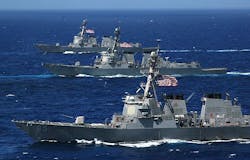Navy relies on ATCA embedded computing system from Artesyn for upgrading Aegis weapon system
Navy experts are ordering the Artesyn ATCA-7480 Quadstar 40G packet processing server blade for the latest efforts in upgrading processing capability in the Aegis weapon system being installed in new Arleigh Burke-class guided missile destroyers, says Robert Persons, senior presales architect for embedded at Artesyn.
The Artesyn ATCA-7480 is going into the Aegis Block III upgrade in an AdvancedTCA (ATCA) 14-slot chassis. The computer board has the dual-processor Intel Xeon E5-2648L microprocessor version 3. The system is specially hardened for shock and vibration for the shipboard electronics application. It runs the RedHawk Linux software operating system.
In the future this architecture is under consideration for backfits to existing Aegis systems aboard existing Arleigh Burke-class destroyers and Ticonderoga-class cruisers, says Persons, who made his comments this week in an interview at the Embedded Tech Trends conference in Austin, Texas.
The Aegis combat system uses powerful computers and radar to track and guide weapons to destroy enemy targets, including incoming ballistic missiles. More than 100 Aegis-equipped ships have been deployed in five navies worldwide. Aegis, not an acronym, refers to the shield of the mythical Greek God Zeus.
Aegis was developed by the Missile and Surface Radar Division of RCA, which after a series of acquisitions became part of the Lockheed Martin Corp. Mission Systems and Training segment in Moorestown, N.J. in 1995.
The Navy originally awarded the job to provide embedded computing for the Aegis upgrade to Artesyn in 2015, and qualified the system for installation on Navy warships in 2016, Persons says. This Aegis upgrade job could last as long as six years.
Navy officials also are considering the Artesyn ATCA embedded computing architecture for future embedded computing upgrades to the Ship Self Defense System, as well as the Surface Electronic Warfare Improvement Program (SEWIP).
For the Aegis upgrade, the Navy is swapping out IBM BladeCenter embedded computers for the Artesyn ATCA-7480 ATCA system. Navy officials expect to requalify next-generation Xeon-based Artesyn computer boards for future Aegis technology insertion, Persons says.
Related: Lockheed Martin to upgrade Aegis computer equipment on Navy cruisers and destroyers
Using ATCA for Aegis is part of an Artesyn project to adapt the Network Equipment-Building System (NEBS) design guidelines for the shipboard electronics in Navy surface warships.
Artesyn's Aegis-related work involving ATCA and NEBS is through the Navy and is not specifically tied to Lockheed Martin, Persons says. Managing the Navy's Aegis systems are officials of Naval Sea Systems Command in Washington.
The shipboard electronics environment is particularly demanding for its shock and vibration. Ship electronics must be able to withstand the effects of vibration from engines and other onboard systems, and must be able to withstand the intense shock of missile and torpedo hits.
Navy officials refresh Aegis electronics on a schedule of about every four years. Previously designers had relied on the non-standard IBM BladeCenter architecture for Aegis designs, but wanted to move toward the kind of open-systems architecture with ATCA that they previously used years ago with VME. Aegis has been deployed by the Navy since the 1980s.
Related: Lockheed Martin nets another order to upgrade Aegis computer gear on Navy surface warships
To adapt ATCA and NEBS building blocks to the Aegis Combat System, Artesyn engineers first stiffened an ATCA chassis sides and back, after having adapted the chassis top and bottom to the Aegis shock-isolated rack, Persons says.
Company experts also were able to screw boards into the chassis to resist the effects of shock and vibration. Navy officials say they would like to use this architecture aboard surface warships for eight years or more before considering new technology insertion approaches.
The Artesyn ATCA architecture for Aegis is particularly useful for adapting third-party embedded computing products, which can be modified easily for this architecture, Persons says.
For more information contact Artesyn Embedded Technologies online at www.artesyn.com, Naval Sea Systems Command at www.navsea.navy.mil, or the Embedded Tech Trends conference at www.embeddedtechtrends.com.
Ready to make a purchase? Search the Military & Aerospace Electronics Buyer's Guide for companies, new products, press releases, and videos
